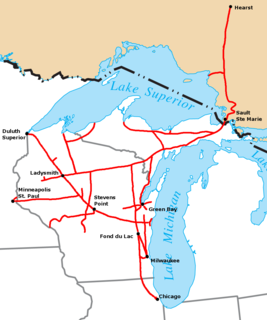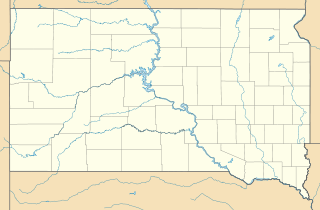The Wisconsin Central Railway Company was created in 1897 when the Wisconsin Central Railroad (1871–99) was reorganized from bankruptcy. In 1954, the name went back to Wisconsin Central Railroad Company. The railroad was merged into the Soo Line Railroad in 1961.

The Soo Line Railroad is the primary United States railroad subsidiary of the Canadian Pacific Railway, one of seven U.S. Class I railroads, controlled through the Soo Line Corporation. Although it is named for the Minneapolis, St. Paul and Sault Ste. Marie Railroad (MStP&SSM), which was commonly known as the Soo Line after the phonetic spelling of Sault, it was formed in 1961 by the consolidation of that company with two other CP subsidiaries: The Duluth, South Shore and Atlantic Railway, and the Wisconsin Central Railway. It is also the successor to other Class I railroads, including the Minneapolis, Northfield and Southern Railway and the Chicago, Milwaukee, St. Paul and Pacific Railroad. On the other hand, a large amount of mileage was spun off in 1987 to Wisconsin Central Ltd., now part of the Canadian National Railway. The Soo Line Railroad and the Delaware and Hudson Railway, CP's other major subsidiary, presently do business as the Canadian Pacific Railway. Most equipment has been repainted into the CP scheme, but the U.S. Surface Transportation Board groups all of CP's U.S. subsidiaries under the Soo Line name for reporting purposes. The Minneapolis headquarters are located in the Canadian Pacific Plaza building, having moved from the nearby Soo Line Building.

Central Station was an intercity passenger terminal in downtown Chicago, Illinois, at the southern end of Grant Park near Roosevelt Road and Michigan Avenue. Owned by the Illinois Central Railroad, it also served other companies via trackage rights. It opened in 1893, replacing Great Central Station, and closed in 1972 when Amtrak rerouted services to Union Station. The station building was demolished in 1974. It is now the site of a redevelopment called Central Station, Chicago.

The Osceola and St. Croix Valley Railway is a heritage railroad in Osceola, Wisconsin owned and operated by the Minnesota Transportation Museum. It operates on former Minneapolis, St. Paul and Sault Ste. Marie Railroad trackage now owned by the Canadian National Railway.
The Wisconsin Northern Railroad is the trade name employed by Progressive Rail Inc. to operate 62.3 miles (100.3 km) of railroad in northern Wisconsin and began operations on November 29, 2004.
Minneapolis is the most populous city in the U.S. state of Minnesota.

La Crosse is an Amtrak intercity train station in La Crosse, Wisconsin, served by Amtrak's daily Empire Builder line. The train station was originally built in 1926 by the Chicago, Milwaukee, St. Paul, and Pacific Railroad, but was also used by the Minneapolis, St. Paul and Sault Ste. Marie Railroad. The station was renovated in 1997 and today is listed on the National Register of Historic Places in Wisconsin as the Chicago, Milwaukee and St. Paul Railway Depot, as well as the Milwaukee Road Passenger Depot.

The Soo Line High Bridge, also known as the Arcola High Bridge, is a steel deck arch bridge over the St. Croix River between Stillwater, Minnesota, and Somerset, Wisconsin. It was designed by structural engineer C.A.P. Turner and built by the American Bridge Company from 1910 to 1911. The bridge was listed on the National Register of Historic Places in 1977 for its national significance in the themes of engineering and transportation. It was nominated for its exceptional dimensions, beauty, innovative engineering techniques, and importance to transportation between Minnesota and Wisconsin.

Crosby station is a historic former train station in Crosby, Minnesota, United States. It was established in 1910. It was listed on the National Register of Historic Places in 1980 as the Crosby Railroad Depot for having local significance in the themes of commerce, industry, and transportation. The depot was nominated for being an essential conduit for the arrival of goods and people and the export of iron ore during central Crow Wing County's economic boom years.

Wisconsin Central Ltd. is a railroad subsidiary of the Canadian National Railway. At one time, its parent Wisconsin Central Transportation Corporation owned or operated railroads in the United States, Canada, the United Kingdom, New Zealand, and Australia.
Soo Line Depot can refer to the following train stations used by the Soo Line Railroad:

The Minneapolis, St. Paul and Sault Ste. Marie Railroad was a Class I railroad subsidiary of the Canadian Pacific Railway in the Midwestern United States. Commonly known since its opening in 1884 as the Soo Line after the phonetic spelling of Sault, it was merged with several other major CP subsidiaries on January 1, 1961 to form the Soo Line Railroad.
Soo Line 2713 is an H-21 class 4-6-2 steam locomotive that was built for the Wisconsin Central Railway in May 1911. The WC had fallen under the control of the Minneapolis, St. Paul and Sault Ste. Marie Railway in 1909, and the locomotive fleets of both railroads were operated in a single pool.

Moose Lake station in Moose Lake, Minnesota, United States, is a depot built in 1907 by the Soo Line Railroad. The building was one of the few buildings that survived the 1918 Cloquet Fire, and it was used to provide shelter for those left homeless in the fires. It was listed on the National Register of Historic Places in 1994 as the Minneapolis, St. Paul, and Sault Ste. Marie Depot.

Thief River Falls station is a historic train station in Thief River Falls, Minnesota. The station was built in 1913 to replace an earlier station and saw passenger traffic until 1967. It was listed on the National Register of Historic Places in 1995 as the Minneapolis, St. Paul and Sault Ste. Marie Railroad Depot and now serves as the Thief River Falls city hall.
Two former railroad stations are listed on the National Register of Historic Places as Minneapolis, St. Paul and Sault Ste. Marie Depot:

Minot station, built in 1912, now houses the Old Soo Depot Transportation Museum. It is located in historic Downtown Minot, North Dakota, USA. The depot once served the Minneapolis, St. Paul and Sault Ste. Marie Railroad, which is now part of the Canadian Pacific Railway.

Wilton station in Wilton, North Dakota was built in 1900. Designed by William J. Keith, it was listed on the National Register of Historic Places in 1978 as the Minneapolis, St. Paul and Sault Sainte Marie Railroad Company Depot. It is also known as Soo Line Depot.

The Pollock Depot is a historic former railroad station on Avenue A in Pollock, South Dakota. It is a wood-frame structure with a gable roof, with two sections, one two stories, and the other a single story. The station was built in 1901 to Plan 3104, one of five plans used by the Minneapolis, St. Paul and Sault Ste. Marie Railroad for its stations. The establishment of the station at this location resulted in the founding of the town of Pollock, whose buildings were moved here from other area communities. The single-story section, divided into seven sections by large brackets, originally housed freight, while the two-story section provided passenger facilities on the first floor housed living quarters for railroad workers.

Outlook station is a railway depot in Outlook in Sheridan County, Montana which was listed on the National Register of Historic Places in 1993 as the Outlook Depot. It has also been known as Soo Line Depot. The listing included two contributing buildings.













